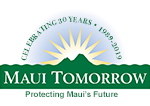As the controversy over proposed development at Olowalu continues, another potentially disastrous situation in the area has already occurred. A mud plume at Ukumehame is now threatening the coral reef at Olowalu, one of the last healthy reefs on Maui with corals over 500 years old. It is an area of rich bio-diversity and one of the few known breeding areas, in the world, for manta rays as well as a nursery area for black tip reef sharks.
Under a Governor’s Emergency Proclamation, following the March 11, 2011 Japan tsunami, Hawaii’s Department of Transportation (HDOT), Highways Division has, without environmental review or oversight, constructed a vertical seawall along Honoapiilani Highway at Ukumehame that permanently alters the shoreline.
Following the tsunami no emergency condition of the road was documented and over 10 months passed before construction began. During that time alternative solutions could have been considered and environmental review taken place. There was no opportunity for community input on potential environmental impacts. Over those long months state and county agencies were only minimally notified and completely eliminated from the process despite their knowledge of coastal processes, engineering standards, and critical best management practices. Had coastal planners been consulted they could have advised HDOT that armored shorelines with vertical seawalls, such as this, are considered to have the greatest impact on natural shorelines.
Instead, contractors exposed an underlying clay layer when dredging the beach to install the sea wall and now that the shoreline has been altered the constant wave action and absence of the beach may cause that clay layer to be suspended indefinitely.
This situation is extremely disturbing as the worst-case scenario for corals is to have a continuous deposit of silt and sediment. And worse yet, two similar projects in the area are planned to start soon. At least one of them is also part of the tsunami relief funding, and as such, may also be exempted from environmental review.
We must do a better job if we value our marine environment. We can start by requiring, where possible, small and permanent inland realignments of the roadway and standardize Best Management Practices, including monitoring, for all emergency shoreline protection projects and require training for constructions crews in order to avoid preventable consequences, such as degraded water quality. We must also refine the definition of “traffic emergency zones” and demand that proposed projects provide clear evidence that emergency conditions are warranted. Lastly, we must discourage HDOT’s common practice of shoreline hardening of coastal roadways.
Our state government must provide better stewardship of Maui’s coral reefs and the marine life therein. Consider a peer-reviewed study, commissioned by NOAA, which reveals the estimated total economic value the American people hold for Hawaii’s coral reefs at $33.57 billion. With tourism still the main economic driver for Maui it only makes sense to conserve this precious resource. Care and preservation of our nearshore waters also safeguards our community’s cultural practices and recreational opportunities
Maui Tomorrow asks Governor Abercrombie to act now to determine what can be done to mitigate the situation at Ukumehame and to make sure that environmental monitoring is a major part of any further actions along the shorelines of Maui.
Ukumehame Mud Plume on Maui, Hawaii from Maui Tomorrow on Vimeo.



